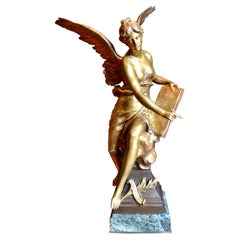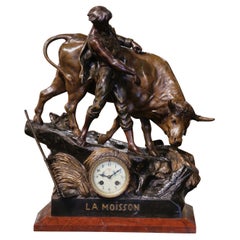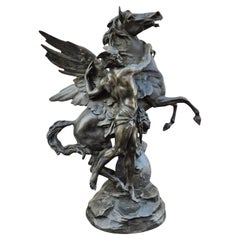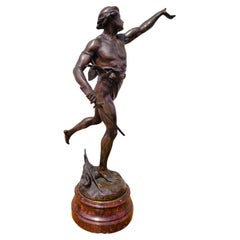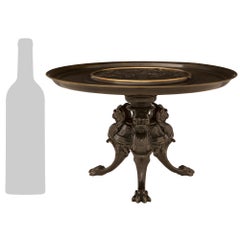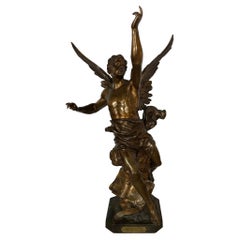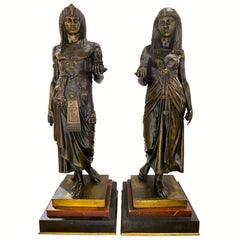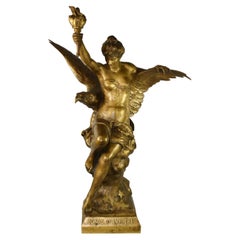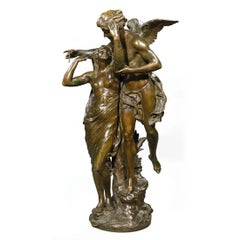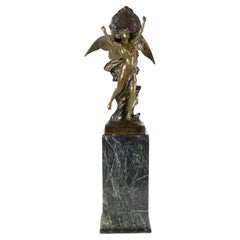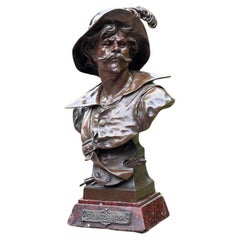E Picault
Antique Late 19th Century French Romantic Figurative Sculptures
Marble, Bronze
Antique Late 19th Century French Medieval Figurative Sculptures
Bronze
Antique Late 19th Century French Animal Sculptures
Spelter
Antique Late 19th Century French Other Figurative Sculptures
Spelter
Antique 19th Century French Napoleon III Figurative Sculptures
Marble, Bronze
Antique 19th Century French Renaissance Centerpieces
Bronze
Antique Late 19th Century French Belle Époque Figurative Sculptures
Bronze
19th Century Figurative Sculptures
Marble, Bronze
Émile Louis PicaultÉmile Louis Picault Orientalist /Egyptian Pair of Bronze Sculptures, 19th Century
Antique 1890s Figurative Sculptures
Bronze
19th Century Figurative Sculptures
Bronze
Antique Early 1900s French Figurative Sculptures
Marble, Bronze
20th Century French Baroque Busts
Marble, Bronze
Early 20th Century French Figurative Sculptures
Marble, Spelter
Antique 1890s French Figurative Sculptures
Bronze
19th Century Figurative Sculptures
Bronze
Antique 19th Century French Neoclassical Table Lamps
Bronze, Ormolu
Antique 1880s French Beaux Arts Decorative Dishes and Vide-Poche
Bronze
Antique 19th Century French Belle Époque Figurative Sculptures
Bronze, Ormolu
Antique 19th Century French Romantic Figurative Sculptures
Bronze
Antique 19th Century French Figurative Sculptures
Bronze
Antique 19th Century French Renaissance Side Tables
Belgian Black Marble, Ormolu
Recent Sales
Antique 1880s French Art Nouveau Figurative Sculptures
Marble, Iron
Antique 19th Century French Figurative Sculptures
Marble, Bronze
Antique 19th Century Figurative Sculptures
Marble, Bronze
Antique Late 19th Century French Figurative Sculptures
Bronze
Antique Late 19th Century American Victorian Busts
Bronze
Antique 19th Century French Napoleon III Figurative Sculptures
Bronze
Antique Late 19th Century French Animal Sculptures
Spelter
Antique Late 19th Century French Medieval Figurative Sculptures
Bronze
Antique Late 19th Century French Renaissance Figurative Sculptures
Spelter
Antique Late 19th Century French Figurative Sculptures
Spelter
Antique 1880s French Napoleon III Inkwells
Marble, Bronze
Antique Late 19th Century French Figurative Sculptures
Bronze
Antique 19th Century French Neoclassical Sculptures
Ormolu, Bronze
20th Century French Neoclassical Figurative Sculptures
Belgian Black Marble, Metal
Antique Late 19th Century French Belle Époque Centerpieces
Bronze
Antique 1890s French Figurative Sculptures
Bronze
Antique Late 19th Century French Art Nouveau Figurative Sculptures
Bronze
Antique Late 19th Century French Belle Époque Figurative Sculptures
Bronze
Antique 19th Century French Romantic Inkwells
Marble, Bronze
Antique Late 19th Century French Mantel Clocks
Marble, Brass, Spelter
Antique 19th Century French Figurative Sculptures
Bronze
Antique Late 19th Century French Neoclassical Revival Centerpieces
Bronze
Antique Late 19th Century French Napoleon III Figurative Sculptures
Bronze
Antique 19th Century French Sculptures
Ormolu, Bronze
Early 20th Century French Figurative Sculptures
Bronze
Antique 19th Century French Neoclassical Figurative Sculptures
Bronze
Antique Late 19th Century French Napoleon III Figurative Sculptures
Bronze
Antique 1880s French Figurative Sculptures
Bronze
Antique 19th Century French Sculptures
Bronze
Early 20th Century French Sculptures
Bronze
Antique Late 19th Century French Beaux Arts Figurative Sculptures
Bronze
Antique 1890s French Neoclassical Figurative Sculptures
Bronze
Antique Late 19th Century French Figurative Sculptures
Metal
Antique 1880s Figurative Sculptures
Antique 1870s French Figurative Sculptures
Bronze
Antique 19th Century French Late Victorian Figurative Sculptures
Bronze
Antique 19th Century French Romantic Figurative Sculptures
Bronze
Antique 19th Century French Figurative Sculptures
Marble, Spelter
19th Century Realist Figurative Sculptures
Bronze
20th Century French Sculptures
Bronze
Antique Late 19th Century French Figurative Sculptures
Bronze
Antique 19th Century French Romantic Figurative Sculptures
Bronze
Antique 19th Century French Sculptures
Bronze
Antique Late 19th Century French Figurative Sculptures
Antique Late 19th Century French Figurative Sculptures
Spelter
Antique Late 19th Century French Figurative Sculptures
Bronze
Early 1900s Modern Figurative Sculptures
Bronze
Antique Late 19th Century French Classical Greek Figurative Sculptures
Bronze
Antique Late 19th Century French Classical Greek Figurative Sculptures
Metal
Antique Late 19th Century French Beaux Arts Figurative Sculptures
Antique Late 19th Century French Neoclassical Revival Figurative Sculptures
Bronze
19th Century Other Art Style Figurative Sculptures
Bronze
Late 19th Century Other Art Style Figurative Sculptures
Bronze
Antique Late 19th Century French Beaux Arts More Furniture and Collectibles
Bronze
Antique 1870s French Figurative Sculptures
Bronze
Antique Late 19th Century French Figurative Sculptures
Bronze
Antique Late 19th Century French Neoclassical Revival Figurative Sculptures
Bronze
20th Century French Tableware
People Also Browsed
16th Century Old Masters Figurative Paintings
Oil
19th Century Rococo Figurative Sculptures
Marble, Bronze
Antique 19th Century French Egyptian Revival Figurative Sculptures
Bronze
Antique 19th Century French Louis XVI Busts
Belgian Black Marble, Bronze
Antique Late 19th Century French Neoclassical Figurative Sculptures
Bronze
Antique Mid-19th Century French Black Forest Animal Sculptures
Walnut
Antique Late 19th Century French Romantic Figurative Sculptures
Bronze
E Picault For Sale on 1stDibs
How Much is a E Picault?
Finding the Right Decorative-objects for You
Every time you move into a house or an apartment — or endeavor to refresh the home you’ve lived in for years — life for that space begins anew. The right home accent, be it the simple placement of a decorative bowl on a shelf or a ceramic vase for fresh flowers, can transform an area from drab to spectacular. But with so many materials and items to choose from, it’s easy to get lost in the process. The key to styling with antique and vintage decorative objects is to work toward making a happy home that best reflects your personal style.
Ceramics are a versatile addition to any home. If you’ve amassed an assortment of functional pottery over the years, think of your mugs and salad bowls as decorative objects, ideal for displaying in a glass cabinet. Vintage ceramic serveware can pop along white open shelving in your dining area, while large stoneware pitchers paired with woven baskets or quilts in an open cupboard can introduce a rustic farmhouse-style element to your den.
Translucent decorative boxes or bowls made of an acrylic plastic called Lucite — a game changer in furniture that’s easy to clean and lasts long — are modern accents that are neutral enough to dress up a coffee table or desktop without cluttering it. If you’re showcasing pieces from the past, a vintage jewelry box for displaying your treasures can spark conversation: Where is the jewelry box from? Is there a story behind it?
Abstract sculptures or an antique vessel for your home library can draw attention to your book collection and add narrative charm to the most appropriate of corners. There’s more than one way to style your bookcases, and decorative objects add a provocative dynamic. “I love magnifying glasses,” says Alex Assouline, global vice president of luxury publisher Assouline, of adding one’s cherished objects to a home library. “They are both useful and decorative. Objects really elevate libraries and can also make them more personal.”
To help with personalizing your space and truly making it your own, find an extraordinary collection of decorative objects on 1stDibs.
Read More
Kazuyo Sejima’s Flowering Tree Blooms Year-Round
The brilliantly simple design turns a modest bouquet into a major statement.
He Wrote ‘Oedipus Rex,’ but Do You Know What He Looked Like?
The Greek tragedian is said to have been handsome in his day.
Cigar Culture Was Once the Peak of Masculinity. Now, It’s a Compelling Curiosity
Even for those who don’t indulge, elegant smoking accessories and audacious art portraying cigar enthusiasts hold a nostalgic allure.
African Travel Plans on Hold? This Ardmore Leopard Vase Brings the Beauty of the Savanna to You
It’s an excellent example of the sought-after ceramics coming out of South Africa’s KwaZulu-Natal province.
With a High-Tech Flagship and Cool Collabs, Lladró Is Breaking the Mold for Porcelain Production
Thanks to its new leadership, the Spanish maker of figurines, busts and lighting is on a mission to update the art of porcelain for the 21st century.
Zoë Powell’s Magnolia 05 Vessel Is Handmade from Clay She Unearthed Herself
The free-form stoneware piece is inspired by the magnolia tree and its associations with home.
8 Ways to Breathe New Life into a Space with Plants
The pair behind the Instagram account @houseplantclub share their tips for making any room of the house gloriously green.
Paris Gallerist Sandy Toupenet Gets Fired Up over 20th-Century Ceramics and Inventive New Makers
Her space on the city’s Left Bank mixes mid-century pieces by the likes of Jean Cocteau and Pablo Picasso with whimsical contemporary creations.
